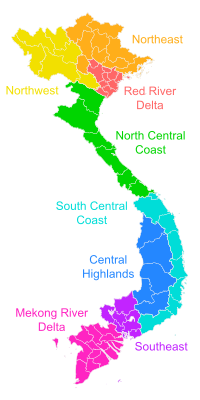
Southern Vietnam (Vietnamese: Nam Bộ) is one of the three geographical regions of Vietnam, the other two being Northern and Central Vietnam. It includes 2 administrative regions, which in turn are divided into 19 First Tier units, of which 17 are provinces and 2 are municipalities. Known as Nam Bộ today in Vietnamese since 1975, it was historically called as Gia Định (1779–1832), Nam Kỳ (1832–1945, 1945-1949), Nam Bộ (1945), Bắc Việt (1949-1954), and Nam Phần (1954–1975).[1] Cochinchina or "Nam Kỳ" is a historical exonym for this region, originating during the French colonial period.
The origin of Southern Vietnam (Basse-Cochinchine in French, or Lower Cochinchina) was the Kingdom of Funan (from 1st century CE until 6th century CE) and Khmer Empire (from 8th century CE to 17th century). Southern Vietnam was conquered by the Nguyễn force in the 17th and 18th centuries from the Khmer kingdom.[2]
The main ethnicities in Southern Vietnam are Kinh, Khmer and Chinese.[3]
- ^ Royal Woodblocks of Nguyễn Dynasty – World documentary heritage (2021). "Significant collections § Fonds of the Phủ Thủ hiến Trung Việt or Office of the Governor of Trung Viet". mocban.vn. The National Archives Center No. 4 (State Records and Archives Department of Vietnam). Retrieved 30 March 2021.
- ^ Cooke, Nola (1998). "Regionalism and the Nature of Nguyen Rule in Seventeenth-Century Dang Trong (Cochinchina)". Journal of Southeast Asian Studies. 29 (1): 122–161. ISSN 0022-4634.
- ^ Ho, Hoang-Anh; Martinsson, Peter; Olsson, Ola (2022-03-01). "The origins of cultural divergence: evidence from Vietnam". Journal of Economic Growth. 27 (1): 45–89. doi:10.1007/s10887-021-09194-x. ISSN 1573-7020.